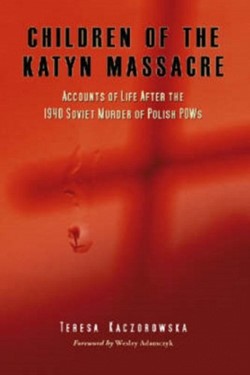Children of the Katyn Massacre

Children of the Katyn Massacre - Accounts of life after the 1940 Soviet Murder of Polish POWs
Teresa Kaczorowska
2006
ISBN 9780786427567
Jefferson N.C: McFarland
98 Books about Poland | Polish War Graves in Britain
In the spring of 1940 the Soviet NKVD murdered around 25,000 Polish prisoners of war. They were shot on the orders of Soviet leader Stalin and head of the Soviet Secret Police (NKVD) Beria. After the Soviet Union invaded Poland on 17 September 1939 they sent captured Polish army officers to prison camps in the Soviet Union at Kozelsk, Ostashkov and Starobelsk.
On 5 March 1940 Stalin signed the execution order approving the murder of 25,700 Polish prisoners of war. During April and May 1940 the Polish prisoners were gradually taken from the prison camps, shot and buried in mass graves.
| Prison Camp | Mass Grave | Number Shot |
|---|---|---|
| Kozelsk (Russia) | Katyn Forest (Russia) | 4,421 |
| Ostashkov (Russia) | Miednoye (Russia) | 6,311 |
| Starobelsk (Ukraine) | Kharkov (Ukraine) | 3,820 |
The author of the book writes that:
These were the career and reserve officers of the Polish Army as well as officials of the National Police, secret service, Border Patrol, judiciary, prison personnel, members of the clergy. At other camps and prisons in the Polish kresy, 3,435 Poles were murdered on territory now part of Ukraine, 3,870 on territory now part of Belarus (together: 7,305). Which adds up to a total of 21,857 victims, comments Roman Sidor...The figures are identical to those given in the secret report of the head of the Committee for State Security of the USSR, A. Shelepin, in 1959. (p.16)
The Katyn Massacre
The mass graves were first discovered in the spring of 1943 after German forces invaded the Soviet Union. The first burial site to be discovered was the one at Katyn forest. The murder of all the Polish officers has come to be known as the Katyn massacre. The Soviet Union denied all responsibility for the murders and blamed them on Nazi Germany. It was not until 1990 that Russian leader Mikhail Gorbachev admitted that the Soviet NKVD had been responsible.
For the children of those murdered at Katyn any public mention in communist Poland that their fathers were shot at Katyn brought persecution from the Soviet authorities. It was only after the fall of communism in 1989 that they could speak freely about what had happened. In 2000 three cemeteries were opened and dedicated at Kharkov (17 June), Katyn Forest (28 July) and Miednoye (2 September). It was then that the author of this book, Teresa Kaczorowska, decided to try and contact children of Katyn and discover what their lives had been like. She writes that:
This is the first reporter's book which describes, using the life-stories of yet living witnesses of history as its foundation, how extremely complicated and dramatic were their lives. Surely their fathers - later Soviet prisoners of war, the elite of the Polish nation, steadfast patriots, they who had after the long partitions built the new-born Second Republic - could not have foreseen such a destiny...The children of the murdered officers have lived to see the crime brought to life...and they need no longer hide the truth. (Foreword, p. 6)
One of the children in the book was involved in the exhumation of the bodies in 1995 and 1996 at Kharkov. She states that:
What did we recover besides human remains? Over ten thousand objects belonging to those murdered: documents, money, decorations, military equipment, mess kits, canteens, cigarette cases. A good many books: Kraszewski, Sienkiewicz, textbooks. In addition many buttons, watches, holy medals, rings, family signet rings...All of them have made their way to the Katyn Museum in Warsaw...Among the prisoners of war in Starobelsk there were 300 doctors - that's why we would find during the exhumations ampoules, needles, medicine, medical instruments and stethoscopes, thermometers, bandaging material. (p. 44)
At the Kharkov cemetery those buried there include:
Eight generals...: Stanislaw Haller, Leonard Siekierski, Leon Bilewicz, Aleksander Kowalewski, Kazimierz Orlik-Lukowski, Franciszek Sikorski, Konstanty Flisowski and Piotr Skuratowicz. Likewise there are 55 colonels, 127 lieutenant-colonels, 230 majors, around 1000 captains and cavalry captains, 2400 lieutenants and second lieutenants. (p. 248)
The book contains 18 reports, based on personal interviews, describing the fates of the children of Polish officers. The name of the Polish officer concerned is shown after the chapter titles listed below.
Book Chapters
- The Eleventh Urchin of Lvov - Wladyslaw Antoni Sidor
- Construction Engineer/Publisher - Zdzislaw Spanily
- A Participant in the Exhumation - Julian Lucjanowicz
- American Professor - Marcin Kaminski
- The Little Prince and the Fairy Tales - Jan Franciszek Adamczyk
- Little Ewa Always in Ribbons - Stanislaw Madejski
- Faithful to the Blue Uniform - Michal Nastarowicz
- In Love with the Land of his Birth - Aleksander Korzybski
- When Tape Seals Our Lips - Kazimierz Roman Grabowski
- Custodian of the House with the Turret - Bronislaw Holub
- Witness to more then one Crime - Jozef Wasilewski
- Stalwart from the Podkarpacie Region - Ignacy Dec
- Maja and the Cherries - Zygmunt Puchalik
- Emigre Because of Martial Law - Jerzy Kismanowski
- Devotee of Freedom - Romuald Horoszowski
- Fugitive from the the Sailing Vessel Dar Pomorza - Stanislaw Swianiewicz
- Child of Two Cultures - Robert Dresdner
- Katyn Pilgrims - Oskar Lange
- Kozlowski - Jane Rogoyska (Katyn)
- Katyn - Death in the Forest - J K Zawodny (Polish Army Officers)
- Katyn Massacre - Louis Fitzgibbon (Polish Army Officers Murdered 1940)
- Katyn - A Crime Without Punishment (Polish Army Officers Murdered 1940)
- Katyn (The Film) - Directed by Andrzej Wajda (Polish Army Officers Murdered)
- In The Shadow of Katyn - Stanislaw Swianiewicz (Polish Army Officers Murdered)